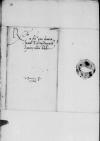List #2968
Sigismund II Augustus Jagiellon do Ioannes DANTISCUSVilnius, 1546-05-20
| odebrano Heilsberg (Lidzbark Warmiński), 1546-06-05 Rękopiśmienne podstawy źródłowe:
Publikacje:
| ||||||||||
Tekst + aparat krytyczny + komentarz Zwykły tekst Tekst + komentarz Tekst + aparat krytyczny
Reverendo in Christo Patri, domino
Reverende in Christo Pater sincere nobis dilecte.
Simula ms. al(!)
⌈lala ms. al(!)
⌉tque venisset ad nos illustr(issimus) or illustr(is)⌈illustr(issimus)illustr(issimus) or illustr(is)⌉
dominus
Et bene valeat.
Dat(um) or Dat(ae)⌈Dat(um)Dat(um) or Dat(ae)⌉
Ex commissione
s(erenissimae) or s(acrae)⌈s(erenissimae)s(erenissimae) or s(acrae)⌉


 Bcz, 1618, p. 82 (36)
Bcz, 1618, p. 82 (36)